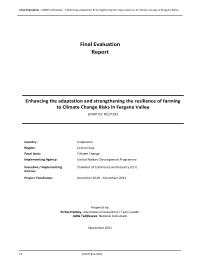
Final evaluation: Enhancing the adaptation and strengthening the resilience of farming to Climate Change Risks in Fergana Valley
Output 1.3.1 National capacities and evidence-based assessment and planning tools enable gender-responsive and risk-informed development investments, including for response to and recovery from crisis
Goal 1. End poverty in all its forms everywhere
Goal 10. Reduce inequality within and among countries
Goal 13. Take urgent action to combat climate change and its impacts
1.5 By 2030, build the resilience of the poor and those in vulnerable situations and reduce their exposure and vulnerability to climate-related extreme events and other economic, social and environmental shocks and disasters
10.3 Ensure equal opportunity and reduce inequalities of outcome, including by eliminating discriminatory laws, policies and practices and promoting appropriate legislation, policies and action in this regard
13.1 Strengthen resilience and adaptive capacity to climate-related hazards and natural disasters in all countries
1: Others
2: Poverty
3: Resilience


